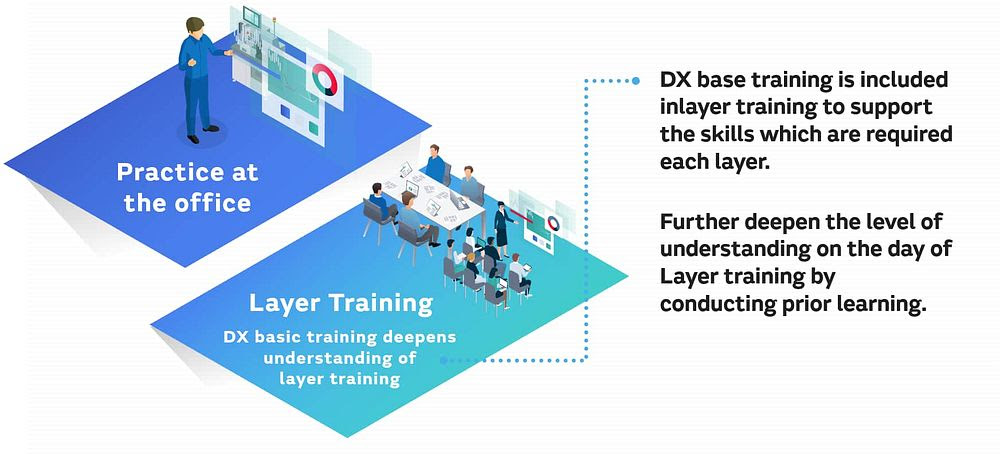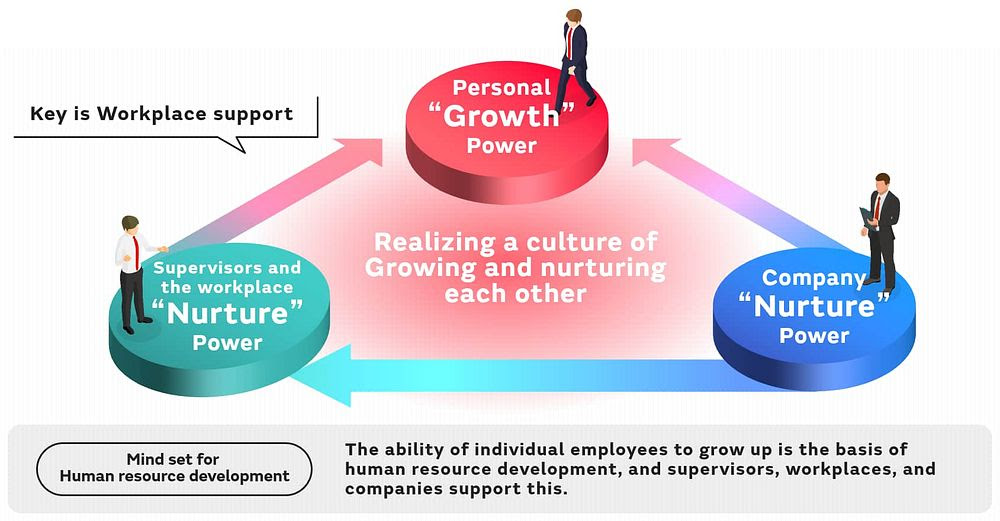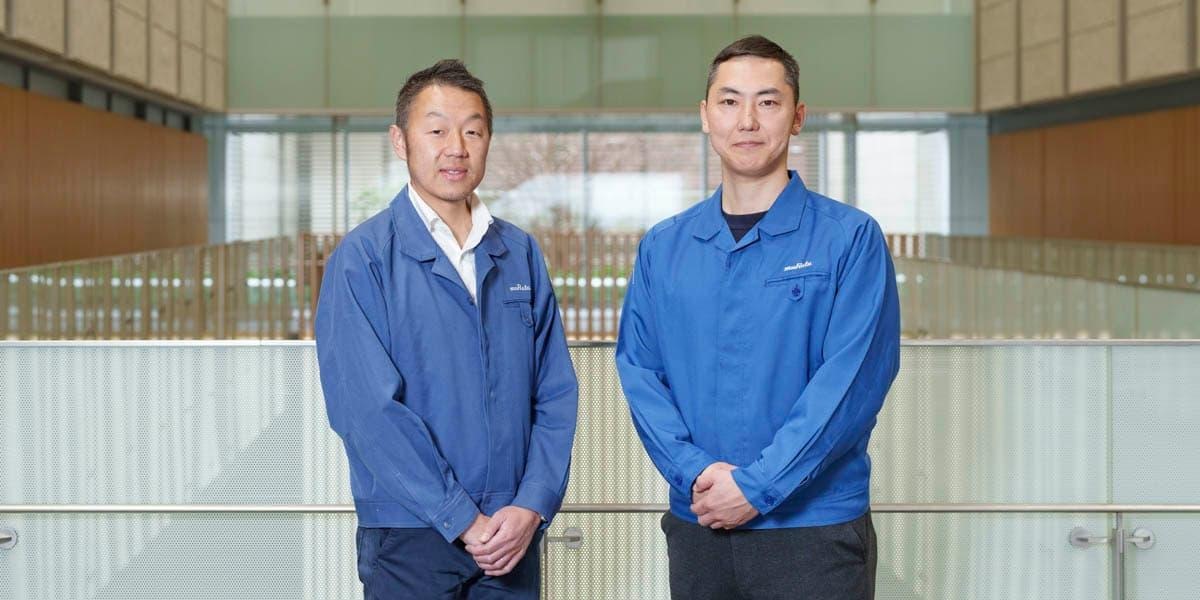While DX continues to become more common throughout society, digital human resource training to promote DX has become especially important. Murata, engaged in DX activities in various fields, has launched a human resource training project to train personnel required for DX promotion. Nishida of the Human Resource Development Division and Takano of the Information System Management Department will provide explanations concerning the project overview and it’s aim.
1. Basic training and job type training to develop DX human resource
The human resource training project to train personnel required for DX promotion officially began in April 2022, at the beginning of the medium-term direction 2024. Nishida and Takano reflect on its development.
Nishida: “Murata has been promoting DX in various fields. Through these activities, discussions to determine which level of employees require a change in awareness in order to disseminate DX throughout the entire company. I then went on to speak to Takano (who was a member of the Management Strategy Department at the time), who had been considering establishing a DX human resource training strategy.”
Takano: “While promoting DX human resource training as a corporate initiative, I was always thinking about how it can impact the entire company by considering its aspects as a surface and not as a point. Our employees were confused by the word DX. For example, they were unsure of what they were to do and perplexed at the realization that something was going to change. Especially, since the Manufacturing Department tends to focus more on the differences generated by the effects of DX, we had discussions with the Human Resource Development Department on how we were to disseminated DX.”
So we created a concept for DX human resource training from the job type training and basic training perspectives, and started to realize it from there.

DX human resource training and aim
Nishida: “Basic training is implemented for all employees, regardless of their type of work and title. It covers a wide range of topics including basic knowledge on DX as well as task improvement. Additionally, we have applied job type training in order to train personnel who can act as the flag-bearer for DX within the organization in order to enhance organizational capabilities.

Linking DX basic training and training by level
Takano: “Job type training is further broken down into 2 axes. One is an approach that covers the horizontal axis, or levels, such as managers, leaders, and site managers. This can be implemented for all levels regardless of the organizational function. The other is a vertical approach that conforms with organizational functions such as manufacturing, R&D (research and development), and product development.”
2. Acquiring independent thinking that enables backwards calculation from the objective to achieve the means
After constructing a portal website that shares LMS (Learning Management System) and internal DX examples, Takano has stated, “Job type training required developing individual human resource training programs for each level and organization with their functions and characteristics in mind.”
Takano: “At Murata, central office employees approach manufacturing bases on a daily basis to discover new issues. We then created an image of the type of person Murata should strive to train and developed a program per job type. For example, we had 3 training courses for the manufacturing department, and provided training that combined lectures and practical work.”
Optimization of programs based on level and organization is the aim of job type training.
Takano: “The level of awareness and difference in interest for DX as well as the environment varies by department. For example, it is easy to assume solutions that make use of a digital tool called RPA (robotic process automation) since massive amounts of data are accumulated in the manufacturing department on a daily basis. On the other hand, the R&D department is required to gather data themselves, and is incapable of accumulating the same amount of data as in the manufacturing department. Therefore, for the R&D department, we have created a program that includes training to acquire skills related to machine learning in order to generate improvement.”
In addition to inputting knowledge and data, it features training aimed to have participants think for themselves and autonomously output their ideas. Takano states, “Digital tools introduced simply as a means without objective are not effective and you cannot expect any lasting results. It is crucial to achieve a mindset capable of calculating the means from the objective to achieve a goal you aim to attain.”
Takano: “To achieve this mindset, we offer a program in which we dispatch central office employees as lecturers to each business site and have them discuss issues with managers as well as participating trainees to determine what kind of solutions can be achieved and try to visualize them. Participants are selected by managers and we have the managers determine how these participants are to be trained. Finally, the managers are to properly evaluate the participants’ growth and proposals. It isn’t simply a training program. We aim to stimulate the organization by achieving proper praise and results.”
Nishida: “Everyone should be active as a mentor and actively take part in training. In addition to this project, this is a mindset common to Murata’s human resource training. We believe people grow the most by developing growth capabilities such as individualism and creativity with organizations and companies sufficiently backing these activities up.”
3. Creating an organizational culture that disseminates DX through experiences of success
Through these DX human resource training activities, Nishida claims to have witnessed the growth of many employees.
Nishida: “Among the participating employees, there were some who acquired the IT passport. They’ve stated that, in addition to acquiring logical thinking skills and knowledge on marketing, a new common language was established while promoting DX, making communication with employees from other departments smoother. Since a need for innovation through cross-departmental collaboration is on the rise, I believe we were successful in cultivating very important viewpoints and perspectives.”
Nishida continued to mention that significant results were achieved during a training program in which new recruits would visit factories for practical training to discover solutions from new perspectives and share them.
Nishida: “We had our new recruits attempt to discover solutions from various perspectives such as task efficiency, cost reduction, and quality improvement. The main objective was to have them experience Murata’s manufacturing sites as well as the organizational culture with deeply rooted improvement and extend relationships with other departments. However, many of our new recruits were capable of delivering highly effective solutions and I believe it was extremely meaningful to have them actually visit the factories.”
Takano continued to state that these specific results were extremely crucial when motivating and developing personnel.
Takano: “It is impossible to change one’s mind through training and education. I believe people do not change unless they are exposed to actual experiences that include experiences of success. Productivity, work efficiency, and product quality rose through the use of digital tools. I believe a person’s mindset would only start to change after experiencing these results, leading to the dissemination of DX. To create a culture in which employees openly engage in DX based on actual experiences, it is crucial that organizations and companies back up these activities and make sure they continue.”
Nishida: “I believe only about 10% of a person’s mindset will change through training and education. These activities are merely an opportunity. It is important to acquire skills and knowledge, and achieve results, starting from areas you are familiar with. For example, you can start by going paperless. We would like to promote opportunities that offer successful results however small they are, and disseminate DX throughout the entire company.”

A support structure to develop “growth”
4. Make DX a corporate culture of Murata to continue providing new values
I believe we can see indications of change within the company through human resource training required for DX promotion.
Takano: “There are more opportunities for DX promotion throughout the entire company and we have fostered an atmosphere where employees that apply digital methods are acknowledged and recognized. In the near future, there will be a severe lack of digital human resources. However, Murata is a place to learn, foster, and apply digital techniques. I believe DX will play a major role in increasing a company’s appeal and value.”
Nishida: “There are various forms of individual will and we are preparing an environment that will promote them through DX. I hope that our employees can expand their capabilities by acquiring the proper set of skills and knowledge through this training program, and thus creating opportunities to challenge new things.”
Nishida states, “DX will not take root in a mere 1 or 2 years of training. It requires a long-term perspective.” However, he concluded that DX dissemination will lead to generation of a greater value.
Nishida: “DX is not a goal. It is a process. However, it is also an unavoidable process. DX is required for Murata to continue offering new values even if the future society and market are to change. In order to acknowledge changes and adapt to these changes, it is crucial to learn more about DX and continue putting it into practice. Therefore, I would like to continue providing human resource training required for DX promotion.”
Takano: “Personally, I would like to make the terms digital and DX common things so we wouldn’t have to mention the terms when talking about them. This implies DX has been rooted in Murata’s corporate culture. We aim to make DX a corporate culture based on our company creed to improve our skills. This is one of our current goals.”


















